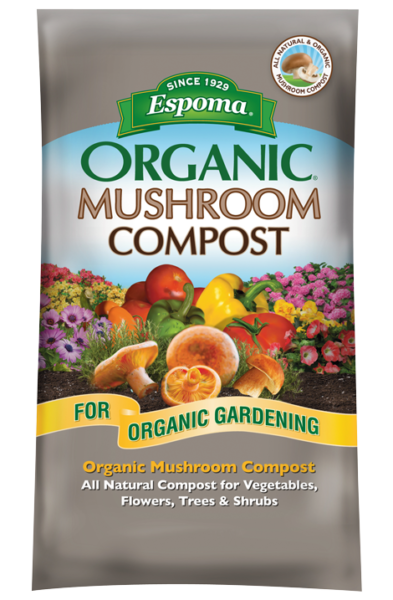- Mushroom Compost Helps Improve Poor Soils
- Better soil helps grow better plants
- For everything you plant
Use at time of planting to improve poor soils.
Add 2 to 3 inches of Espoma® Organic Mushroom Compost to your garden area. (See chart below.)
Add the appropriate amount of Bio-tone® Starter Plus for the area.
Mix or rototill compost with the existing soil to a depth of 4-6 inches. Mix soil well. Level with rake.
Plant seeds or live plants fallowing package directions or tag instructions.
Water thoroughly after planting, then daily as needed until plants are established.
Begin regular fertilizer program 30 days after planting.
| USAGE CHART | ||||
| Number of Bags to Cover Area | ||||
| Total Area to Cover ( sq. ft.) | 24 | 48 | 72 | 96 |
| Bags to Cover 2″ Depth | 5 | 11 | 16 | 21 |
| Bags to Cover 3″ Depth | 8 | 16 | 24 | 32 |
Planting Trees & Shrubs:
Dig a hole as deep as the root ball and twice as wide.
Place the plant in the hole so that it is sitting at or above the same depth that it was previously growing (Use soil mark on trunk as a guide).
Add Espoma Organic Mushroom Compost to the native soil so that the soil to backfill the hole is equal parts native soil and compost.
Add the appropriate amount of Bio-tone® Starter Plus.
Fill the hole with amended soil. Pack firmly, soak it with water and allow to settle. Add additional soil if needed.
Add mulch to conserve water and control weeds. Keep well watered until plant is established.
Established Plants:
Add a ½ to 1“of Espoma Organic Mushroom Compost on the soil surface around the plant. Water thoroughly.
For Planting Beds:
Mix or rototill compost with the existing soil to a depth of 4-6 inches. Mix soil well. Level with rake.
Individual Plants:
Add Espoma Organic Mushroom Compost to the native soil so that the soil to backfill the hole is equal parts native soil and compost.
Fill the hole with amended soil. Pack firmly, soak it with water and allow to settle. Add additional soil if needed.
